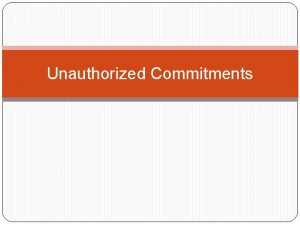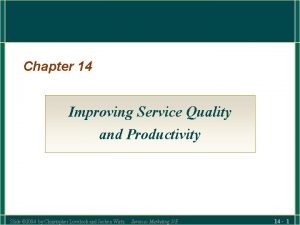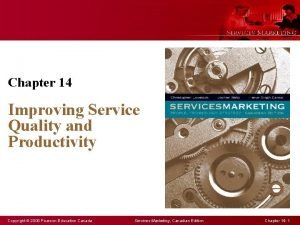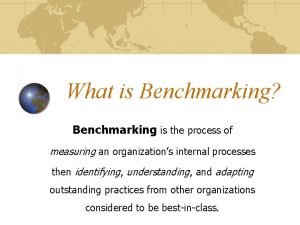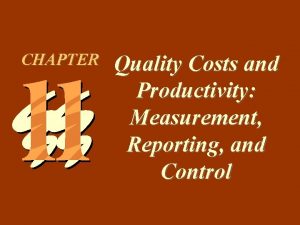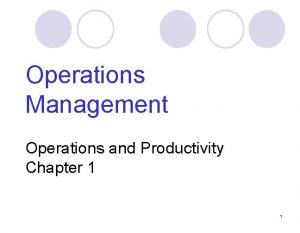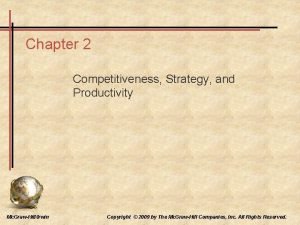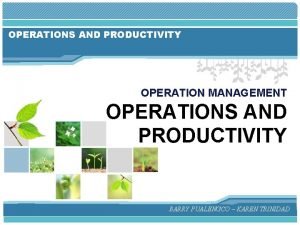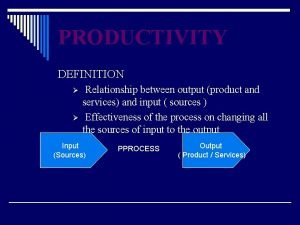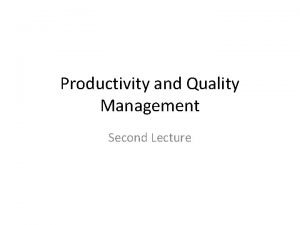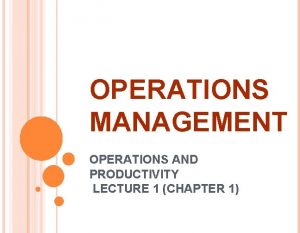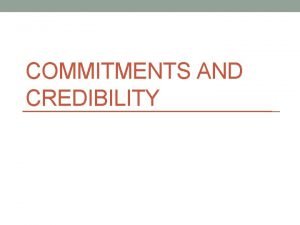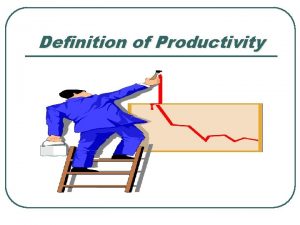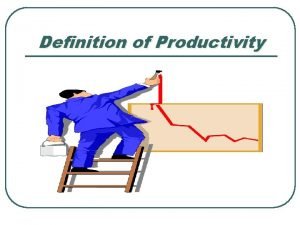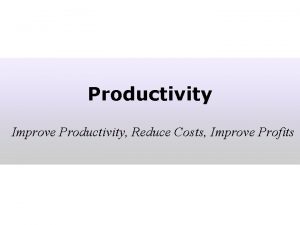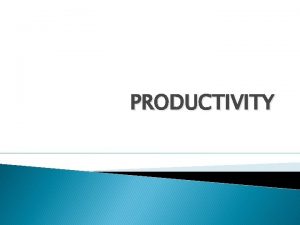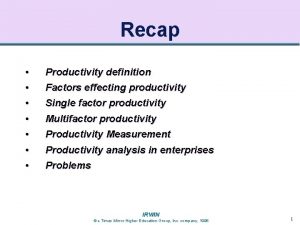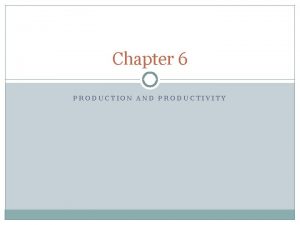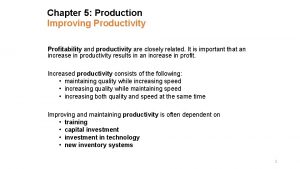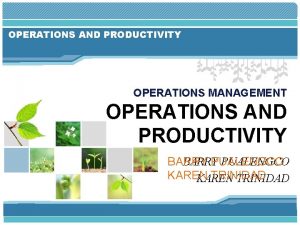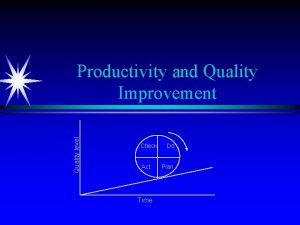Managements Commitments to Quality and Productivity Chapter 4


























- Slides: 26

Management’s Commitments to Quality and Productivity Chapter 4 MANAGEMENT Meeting and Exceeding Customer Expectations EIGHTH EDITION Prepared by Deborah Baker Texas Christian University Copyright © 2005 by South-Western, a division of Thomson Learning. All rights reserved 1

learning objectives 1. Discuss how customers influence the quality of goods and services 2. Explain why quality must be cost effective 3. Relate quality, productivity, and profitability to Chapter 4 one another Copyright © 2005 by South-Western, a division of Thomson Learning. All rights reserved 2

learning objectives (continued) 4. Discuss the commitments required to improve quality and productivity at the following: a. The top of organizations b. The middle of organizations c. The bottom of organizations 5. Discuss the external commitments required to Chapter 4 improve an organization’s quality and productivity Copyright © 2005 by South-Western, a division of Thomson Learning. All rights reserved 3

1 Customer Satisfaction Model Quality Component Satisfaction Performance Handle Complaints Recommendation Company’s Representative Product Availability Customer Satisfaction Retention Services Profitability Chapter 4 Billing Price and Contracts Copyright © 2005 by South-Western, a division of Thomson Learning. All rights reserved 4

1 Origination of Quality Features Internal Designers External Designers Producers Chapter 4 Users Customers Copyright © 2005 by South-Western, a division of Thomson Learning. All rights reserved 5

1 Quality Function Deployment A disciplined approach to solving quality problems before the design phase of a product Purpose is to assure customer obtains high value from product Chapter 4 Benchmark The product to meet or beat in terms of design, manufacture, performance, and service Copyright © 2005 by South-Western, a division of Thomson Learning. All rights reserved 6

1 Quality Function Deployment Long-Term Value Disciplines Operational excellence Product leadership Chapter 4 Customer intimacy Copyright © 2005 by South-Western, a division of Thomson Learning. All rights reserved 7

1 Total Quality Management Chapter 4 Total Quality Management A strategy for continuously improving performance at ever level, and in all areas of responsibility Continuous quality improvement Leadership through quality Managing total quality Total quality control Copyright © 2005 by South-Western, a division of Thomson Learning. All rights reserved 8

Chapter 4 1 The TQM Model Source: Department of Defense, Quality and Productivity Self-Assessment Guide for Defense Organizations (Washington, D. C. Department of Defense, 1990). Copyright © 2005 by South-Western, a division of Thomson Learning. All rights reserved 9

1 TQM Principles. Quality improvements create productivity gains. Quality is defined as conformance to requirements that satisfy user needs . Quality is measured by continual process and product improvement and user satisfaction . Quality is determined by product design and achieved by effective process controls . Process-control techniques are used to prevent defects. Quality is part of every function in all phases of the product life cycle Chapter 4 . Management is responsible for quality. Relationships with suppliers are formed for the long term and are quality-oriented Copyright © 2005 by South-Western, a division of Thomson Learning. All rights reserved 10

Productivity 2 Productivity Chapter 4 Output Input The relationship between the amount of input needed to produce a given amount of output and the output itself = Productivity Index Copyright © 2005 by South-Western, a division of Thomson Learning. All rights reserved 11

2 Improving Productivity. Increase the amount of output generated by a fixed amount of input . Reduce the amount of input required to generate a fixed amount of output Chapter 4 . Use a combination of both approaches Copyright © 2005 by South-Western, a division of Thomson Learning. All rights reserved 12

3 Quality–Productivity–Profitability Edwards Deming on Decreasing Costs Reduce mistakes and waste Reduce the need to rework parts Chapter 4 Improve productivity Copyright © 2005 by South-Western, a division of Thomson Learning. All rights reserved 13

Deming’s Chain Reaction 3 Improve Quality Costs decrease because of fewer mistakes, delays, and snags; less need to rework materials; better use of machine time and materials Productivity improves Chapter 4 Capture the market with better quality and lower price Stay in business Provide jobs and more jobs Source: W. Edwards Deming, Out of the Crisis (Cambridge, Mass. : Massachusetts Institute of Technology Press, 1988), p. 3. Copyright © 2005 by South-Western, a division of Thomson Learning. All rights reserved 14

Minimizing Resistance to Change 3 1. Provide participation 2. Provide enough time 3. Keep proposals free of excess baggage 4. Work with the recognized leadership 5. Treat people with dignity Chapter 4 6. Take the other person’s point of view 7. Look at the alternatives Copyright © 2005 by South-Western, a division of Thomson Learning. All rights reserved 15

4 a Commitments at the Top Mission Vision Chapter 4 Core Values A written declaration of an organization’s central and common purpose, its reason for existence Where an organization wants to be in the future Values that should never change, “bedrock principles” Copyright © 2005 by South-Western, a division of Thomson Learning. All rights reserved 16

4 a Ford’s Vision, Mission, and Core Values Our Vision To become the world’s leading consumer company for automotive products and services. Our Mission We are a global, diverse family with a proud heritage passionately committed to provided outstanding products and services that improve people’s lives. Chapter 4 Our Values The customer is Job 1. We do the right thing for our people, our environment and our society. By improving everything we do, we provide superior returns to our shareholders. Source: http: //www. mycareer. ford. com/OURCOMPANY. ASP? CID=23. Copyright © 2005 by South-Western, a division of Thomson Learning. All rights reserved 17

Chapter 4 4 b Commitments at the Middle Quality Improvement Team Meet to assess progress toward goals, identify and solve problems, plan for the future Process Improvement Team Meet to analyze how they can improve the process Project Improvement Team Determine how to make the project better Copyright © 2005 by South-Western, a division of Thomson Learning. All rights reserved 18

4 b Quality Control Audits 1. How are we doing? Chapter 4 2. What are the problems? Copyright © 2005 by South-Western, a division of Thomson Learning. All rights reserved 19

4 b Measurements Chapter 4 Statistical Quality Control (SQC) Statistical Process Control (SPC) Copyright © 2005 by South-Western, a division of Thomson Learning. All rights reserved 20

4 c Commitments at the Bottom Chapter 4 Quality Circle A temporary team, consisting primarily of workers who share a problem, who meets regularly until the problem is solved Copyright © 2005 by South-Western, a division of Thomson Learning. All rights reserved 21

5 External Commitments Chapter 4 “Winning a new customer typically costs a company up to five times as much as keeping a current one and the average business loses 20 percent of its accounts each year. ” Copyright © 2005 by South-Western, a division of Thomson Learning. All rights reserved 22

5 Questions for Outsourcing Chapter 4 . Do they know their costs? . Do we know them? . Are their costs out of line or in check? . Are they working on cost reductions? . Can we help them to reduce costs? Copyright © 2005 by South-Western, a division of Thomson Learning. All rights reserved 23

5 Internal Influences Information Facilities Machinery and Equipment Chapter 4 Materials and Supplies Finances Copyright © 2005 by South-Western, a division of Thomson Learning. All rights reserved 24

5 World-Class Manufacturing Characteristics Chapter 4 . Direct links to customers and suppliers. Flexible production lines. Short cycle times. Horizontal product, project, and process teams. Just-in-time delivery. Cleanliness. Empowered teams and individuals. Focus on efforts to improve quality and productivity Copyright © 2005 by South-Western, a division of Thomson Learning. All rights reserved 25

5 External Influences Economic Legal / Political Sociocultural Natural Forces Chapter 4 Technological Competitors Copyright © 2005 by South-Western, a division of Thomson Learning. All rights reserved 26
 Unauthorized commitments
Unauthorized commitments 4 pillars of sanctuary model
4 pillars of sanctuary model Market entry modes for international businesses (chapter 7)
Market entry modes for international businesses (chapter 7) Core commitments for children
Core commitments for children Service quality and productivity
Service quality and productivity Service quality and productivity
Service quality and productivity Safety quality and productivity
Safety quality and productivity What is benchmark
What is benchmark Cost of quality examples
Cost of quality examples Operation and productivity chapter 1
Operation and productivity chapter 1 The methods and actions taken to accomplish strategies
The methods and actions taken to accomplish strategies Why is productivity important
Why is productivity important Quality control and quality assurance
Quality control and quality assurance Concepts of quality
Concepts of quality Quality control vs quality assurance pmp
Quality control vs quality assurance pmp Quality metrics pmp
Quality metrics pmp Quality assurance cycle in nursing
Quality assurance cycle in nursing Quality improvement vs quality assurance
Quality improvement vs quality assurance Philip crosby formulated the seven deadly diseases
Philip crosby formulated the seven deadly diseases Quality is free: the art of making quality certain
Quality is free: the art of making quality certain Old quality vs new quality
Old quality vs new quality Productivity challenge operations management
Productivity challenge operations management Output/product
Output/product Production and productivity definition
Production and productivity definition Operations and productivity
Operations and productivity Journal on healthy food healthy mind
Journal on healthy food healthy mind Displacement in linguistics
Displacement in linguistics
